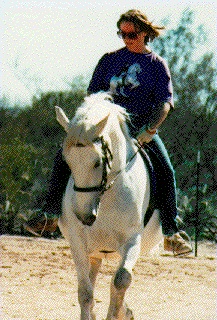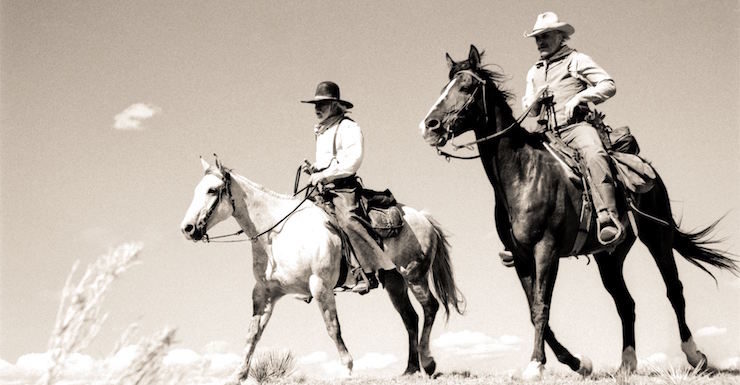As with just about anything else in our culture, when it comes to the myth and lore of horses, stallions persistently get top billing. From Shadowfax to the Black Stallion to Secretariat to the Dancing White Stallions of Vienna, it’s boys, boys, boys. Mares get the standard range of sexism: gentle lady’s mare, saggy old broodmare, too slow to keep up with the boys in a race, too weak to dance the dance of the equestrian manege.
But there wouldn’t be any stallions without mares. Even modern cloning needs a host mare to incubate the fetus, and the original model still had to be produced by the intersection of sperm from a stallion and an ovum from a mare.
Breeders know that the strength of a program is the mares.
No matter how wonderful the sire may be, even if he’s prepotent and stamping his image on his get, the mare still contributes half of the genetic material and all of the gestation and the nurture. It’s quite likely she’s barefoot, pasture-grubby, and out of shape from producing a foal year after year, while the stallion, once he’s made his donation either in person or via the boy-in-box, can dance back to his career. He’ll be gleaming, polished, muscular, and overtly pretty. So of course he gets all the attention—while she does all the work.
If she’s weak, it’s because she’s spending her time making and raising babies, not because she’s innately inferior. Testosterone enhances muscle and bone mass, to be sure, and lets the stallion bulk up faster and keep fit more easily, but ask any polo player, cutting-horse competitor, or show jumper just how weak a toned, fit mare really is. Even racehorse people, if pushed up against the wall, will admit that the fillies can run pretty fast, and fillies like the late, tragic Ruffian and the wildly successful Zenyatta and Rachel Alexandra have held their own against the boys.
And yet the myth machine grinds on, elevating the boys and disappearing the girls. Movie and television horses are persistently male. Hidalgo is a stallion. Shadowfax, again, not to mention Hasufel, Arod, and the non-book-canonical Brego, though maybe some or all of those are geldings; as I presume is the great Bill the pony. The Black Stallion, of course. Fury, wild stallion of the West (I loved that show when I was a small horsegirl). The Lone Ranger’s Silver. Roy Rogers’ Trigger—even Dale Evans’ Buttermilk was a boy. Mr. Ed: male (with a male voice).
Where are the ladies? There’s “My Friend Flicka”, which didn’t last long—it got slammed in the ratings by a (male) dog. The show was adapted from a book by Mary O’Hara, but even literary mares are thin on the ground. Maybe the most illustrious of them is Marguerite Henry’s Misty of Chincoteague. Past that, there’s not much. Even Henry mostly wrote about male horses.
I do have to give props to probably the greatest mare in print, the Hell Bitch from Larry McMurtry’s Lonesome Dove. She’s a Kiowa war mare, and she lives up to her name. She’s the diametrical opposite of poor sad Hwin from C.S. Lewis’ The Horse and His Boy, but she’s a fair bit more accurate as a portrayal of the equine female. I’ll give a nod too to the Black Stallion’s daughter, aptly named Black Minx, who is also Not Your Bitch. As a kid I loved her. I liked all the Black’s family and loved the Island Stallion, Flame (who had an actual science-fiction adventure, OMG), but Minx was a soul sister.
That’s the thing about mares. They can be gentle and calm, and they’re generally less reactive and aggressive than stallions, but they have their own fire. They also have Opinions.
Our culture being what it is, of course that feeds anti-mare sentiment among the horse crowd. Especially in the US and the UK, geldings have become the horse of choice. Stallions are too wild and unpredictable, they say, and mares are too bitchy. Or “mareish,” as the story goes. Best and safest to stick with the nice boys who do not want to kill or breed you, and who do not have Opinions.
Maybe it’s not so much sexist as hormone-ist. Animals with hormones have agendas that aren’t necessarily compatible with human priorities. Removing the hormones removes the imperative to make more horses, with all the things that go with it: stallion aggression and territoriality, mares’ monthly estrus cycles. A mare in estrus may be pretty much the same as she always is, or she might be titchy, reactive, and inclined to squeal when touched.
The variations are highly individual. As with human women, some mares have easy, even silent cycles, and others have strong, painful ones. It is possible to spay a mare, and may be medically necessary if she has serious reproductive problems, but the size of the animal and the location of the organs mean it’s major surgery: difficult, expensive, and dangerous for the mare. Easier in most cases to treat with hormones such as Regu-Mate or various herbal preparations that purport to calm the mare and assuage any discomfort she may feel during her cycle.
But for most mares, that week per month, give or take, isn’t a terrible disruption. They’re a little edgier, a little more reactive, but they’re still their basic selves, whatever that might be.
Horsepeople like to say you ask a stallion, tell a gelding, and negotiate with a mare. Horses, like elephants, have a matriarchal society. Stallions are the defense forces. Mares make the decisions for the herd, raise and educate the young, and maintain a fluid hierarchy under the leadership of an older mare.
This means, for human purposes, that mares are generally pretty calm and will mostly cooperate, but they have to respect you. A really patient mare will put up with stupid; most mares reach a certain point and hit the big Nope. Then depending on the individual personality, she’ll stop cold and refuse to go on, throw in the Giant Kick of Doom (because a mare’s default HELL NO is to let go with the rear artillery), turn around and bite her idiot rider, or just pin her ears back and lash her tail and let the world know how very displeased she is.
Too many humans do not appreciate such utter honesty. But for those who do, and who are willing to pay attention when she expresses her opinions, there’s nothing like a mare. She’s not taking any crap and she expects you to keep up, please, but once you gain her respect, she’ll do anything for you. She’s fierce and loyal, smart and focused, and she’ll give you her best effort. Once a month or so, she might be more like a stallion, but that just adds a bit of spice to the mix.
I just wish more books and films gave mares their due. At least Zenyatta has a blog, and a large following; there’s a chance for people to get to know a great mare and follow along as she pursues her second career as a mom. Which, if you are a horse, is the most important job in the world.

Very pregnant mare showing off for camera, with baby tapping my ankle every so often.
Top image: Lonesome Dove (1989)
Judith Tarr is a lifelong horse person. She supports her habit by writing works of fantasy and science fiction as well as historical novels, many of which have been published as ebooks by Book View Cafe. She’s even written a primer for writers who want to write about horses: Writing Horses: The Fine Art of Getting It Right. Her most recent short novel, Dragons in the Earth, features a herd of magical horses, and her space opera, Forgotten Suns, features both terrestrial horses and an alien horselike species (and space whales!). She lives near Tucson, Arizona with a herd of Lipizzans, a clowder of cats, and a blue-eyed dog.










